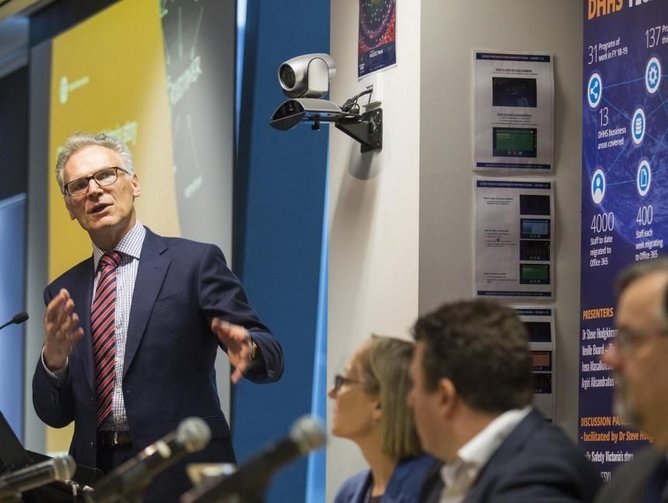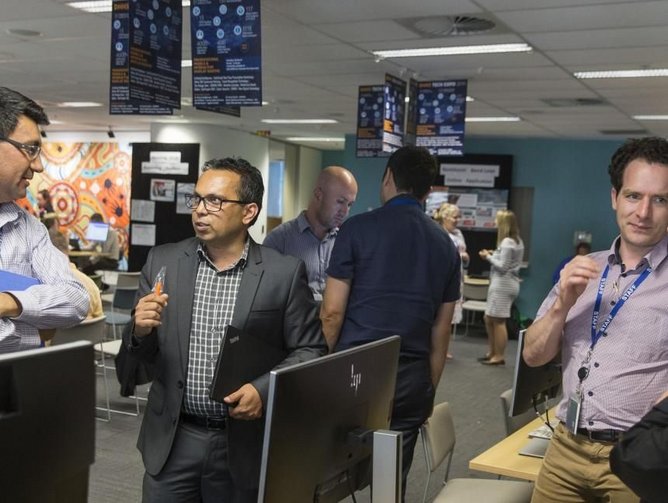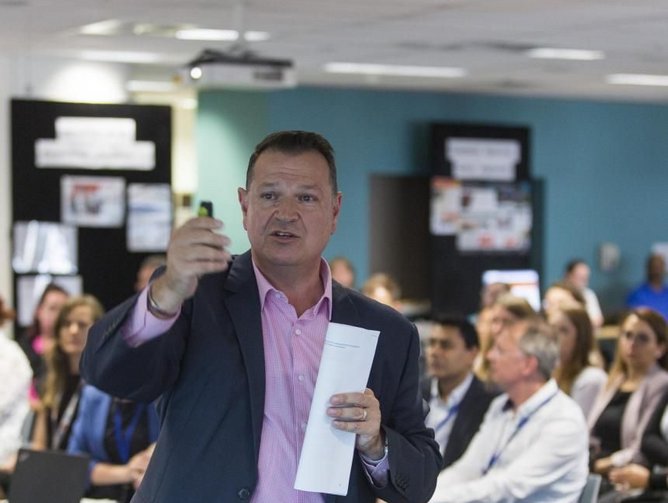The Victorian Department of Health and Human Services accelerates its digital transformation via the Platform+Agile model
The Victorian Department of Health and Human Services (DHHS) is dedicated to ensuring the health and wellbeing of all Victorians, providing a wide range of services ranging from hospital and ambulance services to child protection and family violence programmes and beyond. The department is increasingly finding that digital solutions can offer communities improved services, whether that’s people with a disability being able to easily register for a companion card using its Companion Card System or those applying for public housing using the Housing Register Online Application system. Steve Hodgkinson is CIO at the department, presiding over an ongoing digital transformation alongside his leadership team.
“These days, digital transformation is purely driven by your capacity to execute projects,” says Hodgkinson. “If you can’t execute projects then it’s all just talk. My executive leadership team is at the core of achieving that.” Detailing his team’s successful process, Hodgkinson says that it starts with Fiona Sparks, Assistant Director, Strategy & Design, who is integral to the upfront work required to mobilise and fund a large portfolio of projects. Ray Baird, Assistant Director, Systems Solutions, then leads development of the applications, creating the structure for delivery. Assistant Director, Solutions Engagement, John Henderson manages the project pipeline, liaising with businesses to ensure projects are steadily delivered. David Stephens is Chief Data Officer, responsible not only for data to do with projects but also the broader logic around data collection and information management in a large department, and Liz Hughes, Directorate Manager, provides the support services that keep the branch operating.
Platform+Agile
Alongside his team, Hodgkinson credits the rapid acceleration of the department’s digital transformation efforts to an approach he has pioneered known as Platform+Agile, building out of agile software development methods. “The Platform+Agile model is founded on two main ideas. Firstly, you can’t be agile unless you start with a robust, scalable and sustainable platform. Secondly, public cloud service platforms are faster, more secure, more affordable and simply better in all regards than anything a government agency could ever hope to build or own,” says Hodgkinson. Platform+Agile is the opposite of the usual government approach which sees each application and system as a unique, one-off event. “The fundamental mindset of Platform+Agile is that each application inherits as much as possible of the standard and common functionality of the platform, says Hodgkinson. “Each application is not unique, rather it’s a variation of things that already exist. That enables us to start projects quickly and cheaply, and then to deliver a minimal viable product much more rapidly than otherwise possible, getting feedback from real users and iterating based on that. That simple process is itself the most important accelerant of digital transformation. It is all about increasing the cadence of project delivery to fuel a compounding organizational learning effect.”
By relying on platforms in the way that DHHS does, it is important that platforms are chosen for their versatility and long-term sustainability. “You have to think of platforms strategically as things that you invest in deeply. When the next use case comes along, the question is not how to solve this by going out to market and choosing a new technology and a new vendor, the question is how to deliver this use case using our strategic platform and the things we have already built and have available.” One of the department’s strategic platforms is Microsoft cloud services (Azure, Dynamics and Office365), which has the advantage of many pre-existing synergies such as a government-wide enterprise agreement, Microsoft’s necessary federal government security certifications, the department’s installed base of Microsoft applications, and skills in Microsoft’s development frameworks. The department also makes use of other platforms for different use cases: Salesforce for CRM-style applications; ServiceNow for service management; SAP’s SuccessFactors for human capital management and Oracle Cloud ERP for finance systems.
Hodgkinson observes that the Platform+Agile approach is transforming the logic of technology procurement in his department. It is now a ‘Game of Platforms’ as opposed to a more traditional ‘Game of Tenders’. “Use cases are increasingly contested across our platforms to select the best existing platform for a new application rather than in the past where we would have run a tender to select a new vendor and technology for each application. Vendors need to understand that the game has fundamentally changed. The Game of Platforms is a long game based on maintaining positive and deep strategic relationships, not a transactional game based on winning tenders.”
To be able to scale-up projects to deliver new applications in these cloud services platforms, DHHS has developed a procurement mechanism known as the Solution Delivery Panel. Key vendors on the panel include Access Testing, CSC DXC, Datacom, Dialog, DWS, Firma, Infosys, Landell, Oakton, Plan IT, PM Partners, RXP, SMS - ASG Group, TDL/CNI, Terra and Third Horizon.
Streamlining the process for individual projects, the panel allows the department to maintain strategic relationships with partners rather than relying on a project-by-project approach.
Projects
Hodgkinson and his team have delivered and iteratively refined more than 30 major new business systems, of which he points out a number of exemplary projects that demonstrate the impact possible with the Platform+Agile approach. “The Housing Register Online Application brought together a very fragmented application process for public housing and put it online in a form that could be used on a smartphone,” says Hodgkinson. “That whole process was a radical re-engineering and simplification of the way that people applied for public housing. The received wisdom was that the form and the process were far too complicated to work on a mobile phone. Using the Microsoft Azure framework that we had and its ability to work via smartphone applications, we launched the service and found that a large percentage of clients thought that it was much easier to use than the old paper form process and more convenient to access on a mobile phone than a computer. This taught us how the functionality native in the platform can actually drive innovation in citizen-centric service delivery.”
Another project saw the creation of the Client Incident Management System (CIMS), a unified system for collecting and managing incident reports from over 1,700 agencies in fields such as disability, public housing and child protection. Again using Microsoft Azure, the large number of agencies and sensitive data involved proved the efficacy of the Platform+Agile approach, with the system in seamless operation for some 18 months. The architecture foundations and microservices laid down for that system were later reused, as Hodgkinson explains: “The Victorian Health Incident Management System (VHIMS) has only recently gone live for a cluster of around 50 health services. Previously, a dysfunctional version of that application had been in place for many years and had defied many attempts to replace it. Using the fact that we had already developed a lot of basic functionality and platform features for CIMS, we were able to reuse much of the logic for VHIMS. The project was delivered on time and on budget and has been praised by nurses for reducing significantly the time taken to record incidents. It demonstrates the strength of platform thinking.”
A recent development at DHHS is the launch of SafeScript, a new system for real time prescription monitoring between doctors and pharmacies, preventing the over-prescription of controlled drugs. “SafeScript is an example of the power of the Platform+Agile approach to break through a Gordian knot,” says Hodgkinson. “A project had been running for many years to create a national real time prescription monitoring system, but it was stalling because of the complexity of getting all of the different stakeholders in Australia to agree on the requirements and how the project would be implemented. The Platform+Agile approach doesn’t bother with that. It’s about making the best call you can, implementing the solution and then relying on the fact that a solution provided as a public cloud service can easily scale and be consumed by other jurisdictions to become the national solution.” Since going live, the system has been acclaimed and is being picked up by other states to form the basis of a national system.
As for future projects, Hodgkinson says: “We are still working through a pipeline of applications that need to be modernised or rebuilt. There’s very little that can be done without a digital solution now. The pace at which we can deliver digital transformation is now critical to the government’s ability to deliver its policy and service delivery reform programs.”
It’s clear that DHHS’s digital transformation approach has had a transformative impact on the ways Victorians can interact with the department and draw on its resources. For Hodgkinson, the role of the CIO as it pertains to digital transformation is that of the catalyst. “People have a propensity to want to try and solve the whole of the problem – until they can see a way to solve for the whole then they don’t even get started. The agility that is possible using today’s cloud services platforms means that, as long as you’ve got a sufficient awareness of the big picture and where it can go to, the most important thing is to get started, deliver something and iterate upon it as opposed to agonising forever over trying to solve for the whole integrated solution. I like to say that ‘startegy is usually the best strategy’. Getting started and learning fast is often better than spending too long strategising and failing to actually get around to doing.”





